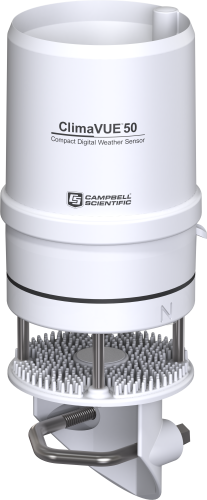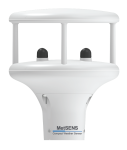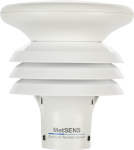This product is not available for new orders. We recommend ordering: ClimaVue 50 G2.

| Services Available |
|---|
概览
The ClimaVue™50 is an affordable all-in-one meteorological sensor that fulfills your common weather monitoring needs with simplicity, when paired with any of Campbell Scientific's highly flexible and scalable data collection platforms. This sensor uses SDI-12 to report air temperature, relative humidity, vapor pressure, barometric pressure, wind (speed, gust, and direction), solar radiation, precipitation, and lightning strike (count and distance). It does this with no moving parts, while consuming little power. A built-in tilt sensor assures long-term data integrity. This diverse product is great for quick deployment, for remote locations, for large networks, as part of a more complex system, or if you just need something simple.
优势与特点
- All the common meteorological measurements with one simple digital (SDI-12) output
- Less than 1 mA at 12 Vdc average current, making it ideal for solar-powered sites
- Integrated tilt sensor helps assure that the sensor stays level over time
- Low maintenance—no moving parts significantly reduces maintenance cost and time
- 304 stainless-steel hardware for minimal surface staining in marine environments
- No sensor configuration required
- Compact design for quick, low-impact installation
- Compatible with all modern Campbell Scientific data loggers
- Detachable cable facilitates field replacement
图像













技术说明
Sensors
All sensors are integrated into a single, small form-factor unit, requiring minimal installation effort. With a robust, no-moving-parts design that prevents errors because of wear or fouling, the ClimaVue 50 is ideal for long-term, remote installations.
Pyranometer
Solar radiation is measured by a pyranometer that is integrated into the lip of the rain gage funnel at the top of the ClimaVue 50. The miniature pyranometer uses a silicon-cell sensor to measure the total incoming (direct and diffuse) solar radiation. Silicon-cell sensors have excellent response time to changing radiation conditions and acceptable sensitivity across the solar spectrum, which make them well-suited for use on the ClimaVue 50.
A carefully developed cosine-correcting head ensures accurate readings regardless of sun angle, while the painstakingly researched optical filter material balances cost and performance to ensure the silicon-cell provides the ClimaVue 50 with good accuracy regardless of temperature or sensor age.
Anemometer
The space underneath the rain gage is where the ClimaVue 50 measures wind speed. Ultrasonic signals emitted from transducers at right angles to each other bounce off the porous sintered glass plate and back up to the opposite sensor. The speed of sound is affected by the wind, and the wind speed is calculated by measuring differences in the time it takes for sound to travel from the transmitters to the receivers.
Temperature Sensor
The ClimaVue 50 temperature measurement is made in the center of the anemometer area where a small stainless-steel needle containing a tiny temperature sensor (thermistor) extends from the middle of the four sonic transducers in the center of the anemometer.
Unlike most air temperature measurements, the temperature sensor is not covered with louvered plates to protect it from solar heating. Instead, it sits in open air, susceptible to solar heating of the instrument body. However, the ClimaVue 50 accurately corrects the measured air temperature because solar radiation and the wind speed are known. These two are the main variables that determine the error between measured air temperature and the actual air temperature. An energy balance equation is then used to calculate what the actual temperature should be to an accuracy of ±0.6°C.
For more information, see the "ClimaVUE™50—Correction of air temperature measurements from a radiation-exposed sensor" technical paper.
Relative Humidity Sensor
The relative humidity sensor on the ClimaVue 50 is located behind the circular Teflon™ screen close to the sonic transducers. The Teflon screen protects the sensor from liquid water and dust while allowing water vapor to freely pass to the sensor. The ClimaVue 50 measures relative humidity and temperature and computes vapor pressure.
Drip Counter Rain Gage
The ClimaVue 50 contains a 9.31 cm (3.67 in.) diameter rain-collection funnel. A spring in the funnel acts as a filter to keep out large particles while allowing enough flow so water does not back up. Rain collected by the funnel exits the funnel through a precision flared hole that forms the rain into drops of a known size. The falling drops hit and momentarily bridge the gap between two gold pins, creating an electrical pulse.
The ClimaVue 50 counts the pulses (drops) and calculates the water volume. As the rain intensity increases, the drops become smaller, but the ClimaVue 50 firmware contains an algorithm to automatically compensate for drop size as the rain increases.
Note: This non-heated sensor is not suitable for solid precipitation measurements or riming environments.
Tilt Sensor
The ClimaVue 50 is also equipped with a tilt sensor. The primary use of the tilt sensor data is to ensure the ClimaVue 50 remains level at all times. Regularly check X and Y tilt data to ensure the ClimaVue 50 is level; if it has tilted, return to the site and level again. Three degrees off level can cause errors in the rain and solar radiation measurements. Although this sensor's readings may be used to level the instrument during installation, it is much easier to use the small bubble level on the bottom of the anemometer plate.
Mounting
The ClimaVue 50 includes a V-bolt for mounting to a pipe with a nominal outer diameter of 31.8 to 50.8 mm (1.25 to 2.0 in.). This allows the sensor to mount directly to a tripod mast or CM300-series mounting pole, or to a crossarm using the 17387 mounting pipe kit.
产品规格
| Measurements Made | Air temperature, barometric pressure, lightning average distance, lightning strike count, precipitation, relative humidity, solar radiation, tilt, wind direction, and wind speed. |
| Output | SDI-12 |
| Operating Temperature Range | -50° to +60°C (Except the barometer and RH: -40° to +60°C.) |
| Minimum Supply Voltage | 3.6 Vdc continuous |
| Maximum Supply Voltage | 15.0 Vdc continuous |
| Minimum Digital Input Voltage |
|
| Typical Digital Input Voltage |
|
| Maximum Digital Input Voltage |
|
| Typical Current Drain @ 12 Vdc | < 1 mA (average) |
| Typical Measurement Duration | 110 ms |
| Maximum Measurement Duration | 3,000 ms |
| Maximum Polling Frequency | 10 s |
| Application of Council Directive(s) |
|
| Standards to Which Conformity Is Declared |
|
| Connection Description | 25 mm (10 in.) pigtail with M12 pin (male) 5-pin 316 stainless-steel knurl |
| Diameter | 10 cm (4 in.) including rain gage funnel |
| Height | 34 cm (13.4 in.) including rain gage funnel |
| Weight | 839.15 g (1.85 lb) |
Power Consumption |
|
| Quiescent | 0.3 mA |
| Maximum Peak Current | 33 mA |
| Average Using the R7! Command every 10 s | 1.0 mA |
| Average Using the R7! Command every 60 s (or slower) | 0.4 mA |
Air Temperature |
|
| Measurement Range | -50° to +60°C |
| Resolution | 0.1°C |
| Accuracy | ±0.6°C |
Relative Humidity |
|
| Measurement Range | 0 to 100% |
| Resolution | 0.1% |
| Accuracy | ±3% RH typical (varies with temperature and humidity) |
Barometric Pressure |
|
| Barometer Operating Temperature Range | -40° to +60°C |
| Measurement Range | 500 to 1100 hPa |
| Resolution | 0.1 hPa |
| Accuracy |
|
Vapor Pressure |
|
| Measurement Range | 0 to 47 kPa |
| Resolution | 0.01 kPa |
| Accuracy or Repeatability | Varies with temperature and humidity; ±0.2 kPa typical below 40°C. |
Wind Speed |
|
| Wind Speed Maximum | 10 s gust |
| Measurement Range | 0 to 30 m/s (0 to 67 mph) |
| Resolution | 0.01 m/s (0.02 mph) |
| Accuracy or Repeatability | 0.3 m/s or 3% (0.67 mph or 3%), whichever is greater |
Wind Direction |
|
| Measurement Range | 0° to 359° |
| Resolution | 1° |
| Accuracy | ±5° |
Solar Radiation |
|
| Measurement Range | 0 to 1750 W m-2 |
| Resolution | 1 W m-2 |
| Accuracy | ±5% of measurement (typical) |
| Spectral Range | 300 to 1150 nm |
Precipitation |
|
| Measurement Range | 0 to 400 mm/h (15.75 in./h) |
| Resolution | 0.017 mm |
| Accuracy | ±5% of measurement (from 0 to 50 mm/h or 0 to 1.97 in./h) |
Tilt |
|
| Measurement Range | -90° to +90° |
| Resolution | 0.1° |
| Accuracy | ±1° |
Lightning Strike Count |
|
| Measurement Range | 0 to 65,535 strikes |
| Resolution | 1 strike |
| Accuracy | > 25% detection at < 10 km typical (variable with distance) |
Lightning Average Distance |
|
| Measurement Range | 0 to 40 km (0 to 24.9 mi) |
| Resolution | 3 km (1.86 mi) |
| Accuracy | Variable |
相关技术文档
技术论文
下载
ClimaVue 50 Example Program v.1 (3 KB) 08-07-2021
An example CR1000X program that uses the R7! SDI-12 command to retrieve data. The program adjusts the barometric pressure measurement to sea level. The adjustment is entered as a constant in the beginning of the program. It assumes the site elevation is 1382 m, and a different value is required for different site elevations.
This program also includes instructions that set wind measurements that are less than 0 to the last valid measurement. These instructions are needed because high winds with rain can temporarily interfere with sonic wind measurements.
常见问题解答
ClimaVue 50: 8
展开全部收起全部
-
Internally to the ClimaVue 50, precipitation is continually measured. Solar radiation, wind, and air temperature are measured every 10 seconds; orientation, vapor pressure, atmospheric pressure, and relative humidity are measured every 60 seconds. Querying the sensor more often than two times the measurement interval will return raw values. Querying more often than the measurement interval will result in duplicate values and may cause timing problems in the data logger.
-
The ClimaVue 50 mounting type can be a meteorological stand, pole in cement, or tripod: 31.8 to 50.8 mm, 1.25 to 2.0 in. diameter. The ClimaVue 50 is fitted with a V-bolt, allowing it to be mounted on top of most posts, poles, tripods, etc. Use a wrench to tighten the bolts, securing the ClimaVue 50 flat and tight against the top of the stand.
-
The average current drain for the ClimaVue 50 during the quiescent state and routine 10 s wind measurement is on the order of 300 µA. Polling with the aR7! command every 60 seconds increases the average current drain to 0.4 mA. Polling with the aR7! command every 10 seconds increases the average current drain to 1 mA.
-
The ClimaVue 50 collects all the information necessary to correct for absorbed radiation using an energy balance approach.
-
The ClimaVue 50 does need to be powered continuously to make the routine wind measurements (every 10 seconds) that are combined to give the wind speed and direction. If you only power up and quickly grab a measurement, those wind speed and direction measurements will be of little value, given the inherently variable nature of wind. Campbell Scientific highly recommends that you power the ClimaVue 50 instruments continuously for reliable wind measurement. The average current drain for the ClimaVue 50 during the quiescent state and routine 10 s wind measurement is on the order of 300 microAmps, so battery drain from continuous power should be minimal.
-
The ClimaVue 50 is a microclimate sensor, so you should position it to be representative of the climate relevant to the research questions you are asking. FAO56 gives specific guidelines to the positioning and field size of sensors. If you intend to use the sensor for reference ET, follow those guidelines. Refer to the following: http://www.fao.org/docrep/X0490E/X0490E00.htm.
-
See the maintenance section of the manual for recommendations.
-
We do not have a heated version of the ClimaVue 50 at this time. The model to correct the air temperature is based on the energy balance and should be good in all situations in which the radiation and wind sensors can collect reliable data; however, unintentional burial in snow and ice may impede the function of both. The ClimaVue 50 will not be a universally great fit for all climates. If the winter precipitation is critical for your study, other instruments will be necessary.
案例研究
Overview In 2020, due to the COVID-19 pandemic, the Formula 1 World Championship calendar was subject......阅读更多
Solar energy is the most abundant clean energy source available on earth, but the intermittent......阅读更多
Summary Problem The University of Birmingham had set up and was operating 26 weather stations across the......阅读更多














